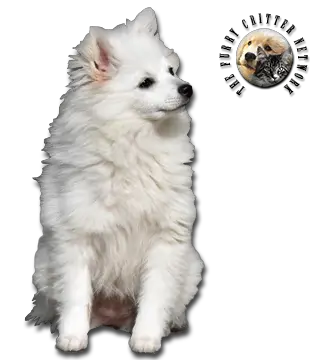Breed Standard
Head: Pyramid shape. Egg-shaped, round skull. Marked stop. Straight nose bridge. Pointed muzzle. Black lips.
Ears: Short and triangular. Held erect.
Eyes: Average size, wide open. Dark ochre color. Black rims.
Body: Square construction. Chest extends to the elbow. Ribs well sprung. Belly very slightly tucked up.
Tail: Always carried curled over the back. Covered with very long hair.
Hair: Bushy, very long and stand-off. Harsh texture. Medium-long on the skull. Short on the muzzle. Feathering on the backs of the legs.
Coat: Solid white, solid red (rare). Champagne is permissible.
Size: Dog: 27 to 30 cm.Bitch: 25 to 28 cm.
Weight: Approx. 5 kg.
History
The Volpino italiano is descended from European spitz that developed in central Italy during the Bronze Age. This ancient breed is esteemed for its natural guard dog instinct. The Volpino italiano looks similar to the German Spitz and the Pomeranian Loulou. The Volpino was loved by palace lords; Michealangelo himself even kept a Volpino. Cart drivers in Tuscany and Latium also favored this fluffy companion. Despite its small size, this dog was originally kept as a guard dog. Its job was to alert the large mastiffs to an intruder. However, due to their lovely temperament and intelligence they also became popular as pets. For unknown reasons the breed's popularity dropped and in 1965 the last dogs were registered. In 1984 an attempt was made to revive the breed. The dogs still living as guard dogs on farms became the new breeding stock. Volpinos remain rare with about 2000 dogs world wide. Most are in Italy but some people are now breeding them in Scandinavia, the UK and the USA.
The AKC FSS declined recognition of the Volpino during the Summer of 2006 due to concern over its similarity to the American Eskimo Dog. As of July 1, 2006, the UKC recognized the Volpino with the same breed standard as the FCI.
Behavior
This lively, cheerful, playful dog has a strong personality. The Volpino is affectionate and a good playmate for children. Wary of strangers, this dog does not hesitate to bark, making him a reliable guard dog. Firm training is required.
The Volpino italiano adapts easily to life as a house dog. Regular brushing is required. This breed should not be bathed too often.
Function
Guard Dog, Pet.
Health
The basic well being and health of the Volpino Italiano breed is far better than with most dogs. At this point in time, the greatest threat facing this race is the genetic mutation of the eye lens called Primary Lens Luxation (PLL).






